what is done to a hockey puck to reduce bouncing and friction before a meet
The Physics Of Hockey
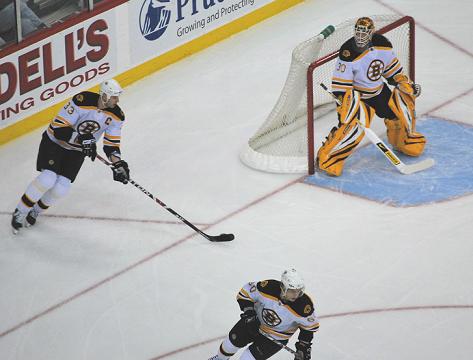
Source: http://www.flickr.com/photos/cubesbyamanda/2385836783
The physics of hockey is a broad field of study of assay, covering fundamental aspects related to performance and equipment design. Experienced hockey players are generally aware of (either directly or indirectly) how physics plays a part in their ability to play the game. The purpose of this page is to discuss how the game of hockey and physics go together.
Note that the information presented below is largely based on the book by Alain Haché: The Physics of Hockey, and the website: http://www.thephysicsofhockey.com
The book past Alain Haché goes into much greater detail on the physics of hockey than I do on this page.
Physics Of Hockey – Skating
When skating, the skates of a hockey player practice two things: They glide over the ice and they push off the water ice with the border, in social club to proceeds speed. Experienced hockey players make this combination of movements expect similar 2nd nature, which is to be expected since they must be able to play offensive and defensive positions, while also controlling the puck.
The concrete properties of water ice is what allows hockey players to maneuver the way they exercise. For case, the low friction of the skate blade with the ice is what allows a hockey player to hands glide over its surface. And the concrete make up of the ice is what allows a thespian to dig in with his skate in order to go around a turn, speed up, or stop.
A hockey thespian propels himself forward by pushing off the water ice with a force perpendicular to the skate blade. Since the friction of the blade with the ice is well-nigh zippo, this is the only way he tin can propel himself forwards. The figure below illustrates the physics behind this principle.
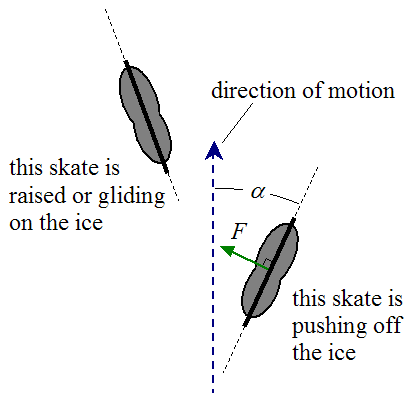
As the hockey role player pushes off with his rear leg, a perpendicular force F is exerted on the skate by the ice. The component of the forcefulness F that points forward (in the direction of movement) is what pushes the player forward. At the same time, his other skate is either raised or gliding on the ice. As he moves frontwards he so switches to the other leg and pushes off the ice with that one, and the process is mirrored. To push off the ice with greater forwards force (and accelerate faster), the skater increases the bending α , which increases the component of forcefulness in the management of motion.
To avoid turning their backs on the opposing squad, hockey players sometimes skate backwards using a gliding blueprint in the shape of a lazy "Due south" (as shown below). In this skating blueprint, the player's blades never leave the water ice. Nonetheless, the player cannot push off confronting the water ice as hard as he does when skating forward, which means he cannot become every bit fast.
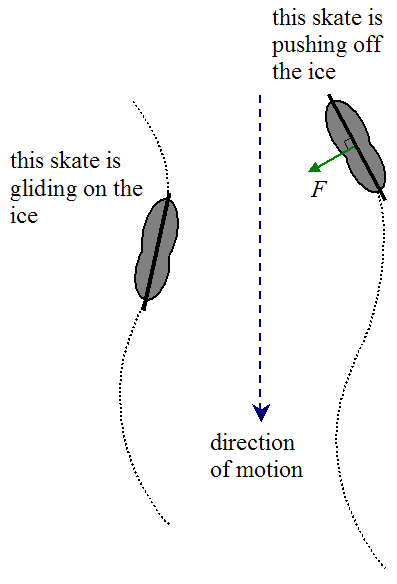
In this technique, the player pushes confronting the ice with his push button-skate facing inwards, while his other skate glides. As he moves backwards he then switches to the other leg and pushes off the ice with that ane, and the process is mirrored. Thus, the physics of skating astern is similar to the physics of skating forward.
A hockey role player tin can at most movement his feet at well-nigh 7 k/s, and the greatest forward push strength will be when he begins skating from rest. At this point the velocity of his foot relative to the ice is vii thou/s. As the histrion gains speed this relative velocity changes. For example, if he reaches a speed of 5 m/s, the relative velocity of his pes relative to the water ice is 2 m/due south (assuming he moves his leg backwards, with no sideways component of velocity), and the push force is less as a issue. Consequently, in that location is a maximum speed a hockey thespian can attain, which is directly influenced by how fast he can move his feet on the ice. However, the maximum speed the thespian tin can reach is not necessarily vii m/s. It can be much more than this if the player, when pushing off the ice, moves his leg backward with a sideways component of velocity. To sympathize this, and to determine the maximum possible speed which can be reached, we must look at the biomechanics of the player on the water ice. The biomechanics of a role player every bit he moves on the ice is some other useful analysis in the physics of hockey.
To maintain his balance when accelerating forward, a hockey player will crouch forward in the direction of motion. This prevents him from falling (tipping) backwards due to the torque caused by the forward component of the force F. By crouching (or bending) forward, the actor is moving his center of mass forrard which creates a counter-torque. This counter-torque balances the torque caused by the forrad component of F, and this prevents him from falling (tipping) backwards.
The blueprint of the hockey skate is some other important factor related to the physics of hockey. A hockey histrion's blades must be able to back up his quick acceleration, turns, and stops. This is accomplished by grinding a slight hollow into the lesser of the blade. This creates two sharp edges which "bite" into the ice, and preclude slipping. The effigy below illustrates this.
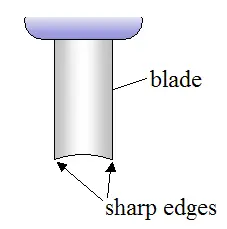
Due to heavy use during a typical game, a histrion's blades must exist regularly kept sharpened in order to maintain optimal operation. If the edges become tedious the effect can exist a thespian's human foot slipping out from under him as he goes around a turn or attempts to stop.
The Puck
A hockey puck is made of a hard vulcanized rubber material, able to withstand the loftier level of wear and tear during a game. They are colored black in society to be highly visible against the surface of the ice.
Hockey pucks are frozen prior to being used in a game. This reduces the level of friction the puck has with the ice and allows it to travel further on the ice, without "sticking". This is convenient from a player's point of view since he prefers to maintain his momentum on the water ice without having to stop and hitting the puck again to get it moving.
Freezing the puck is as well done to intentionally reduce how much it bounces during play. This enables ameliorate control of puck movement.
The Hockey Stick
The hockey stick has several dissimilar features. It is designed to enable skillful puck command, while also being lightweight and strong enough to withstand the stresses placed on it during use.
I of the central features of a hockey stick that affects puck control is the curvature of the bract, which acts as a type of self-centering mechanism. When the puck is struck the curvature of the bract "forces" it towards the bottom of the curve, where information technology tends to sit for the brief duration of touch before flying off. This allows a player to brand more consequent shots since the puck tends to fly off the same office of the blade every time.
However, for the sake of fairness and uniformity of play, regulations typically limit the corporeality of curvature a player'due south blade can have. For instance, in the NHL the maximum curvature is defined as follows: The perpendicular distance from a line drawn from the heel of the blade to the terminate of the blade, and to the point on the blade of maximum distance, shall not exceed 3-quarters of an inch. A diagram of this is shown below.

In the above diagram the maximum commanded distance denoted by the blueish line is iii-quarters of an inch.
Some players curve their blades closer to the end of the blade, which makes it a bit easier to scoop the puck away from another player. Personal preference is a main factor in how players curve their sticks.
Curvature of the blade also allows players to more hands put spin on the puck which gives it gyroscopic stability during flight. This makes information technology more probable that information technology will land apartment on the ice. Applying tape to the blade improves friction between puck and blade. This aids the ability to put spin on the puck.
Some other feature of a hockey stick that affects puck control is the "loft" or "face" of the blade. This is the tilt angle of the blade, visible when looking at the stick from directly above. This is illustrated in the figure below.
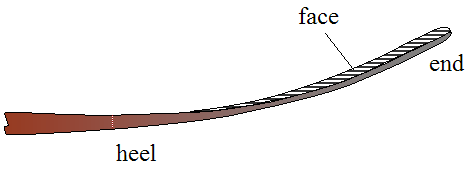
A greater tilt bending makes it easier for a player to elevator upward the puck and get information technology airborne. Again, how much tilt works best comes down to the personal preference of the hockey player.
A feature built into hockey sticks, tailored to a player'southward manner of play, is the angle of "lie". This is the bending the blade makes with the shaft. This is represented by the bending θ in the effigy beneath.
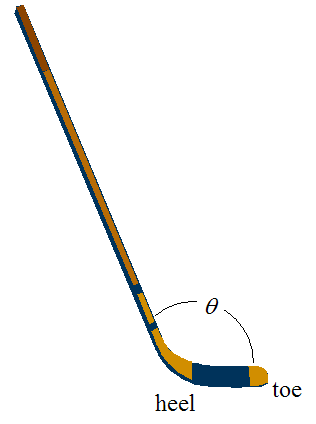
Players usually seek a lie angle that will put their blade apartment on the ice while they are in their typical skating stance.
As shown in the figure above, the toe is the very end of the blade. The toe comes in 2 bones shapes: circular and square. The difference between the ii is that the round toe allows more ability to control the puck at the tip, while the square toe increases the blocking area at the tip.
A proficient option of textile for hockey sticks is carbon fiber. It is lightweight and has high strength. This is of import for ease of puck control and for making shots, such as the slapshot (which will be discussed next). This is a good example of how textile science is an important part of the physics of hockey.
The Slapshot
In the slapshot, players can clock puck speeds of over 100 miles per hour, making it the hardest shot in hockey.
The hockey player begins the slapshot by raising the stick behind his body, every bit shown below.
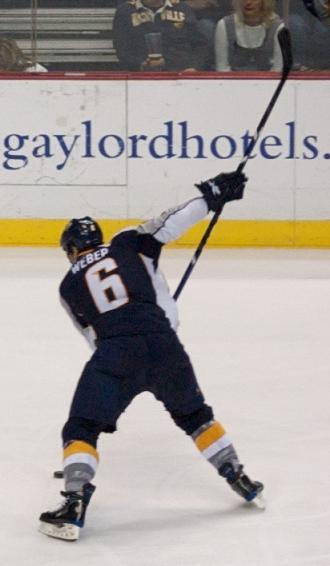
Source: http://en.wikipedia.org/wiki/Slapshot. Writer: http://world wide web.flickr.com/photos/somegeekintn
Next, the player violently strikes the water ice slightly behind the puck, and uses his weight to bend the stick, storing energy in it similar a bound. When the face of the blade strikes the puck the player rotates his wrists and shifts his weight in order to release this stored energy and transfer it to the puck. The event is the puck reaching a speed faster than information technology would if the player merely hit the puck directly. The kinetic energy of the puck after impact is equal to the stored free energy in the hockey stick.
The figure below shows the point of bear upon betwixt the stick and puck. You can clearly come across the bend in the stick.
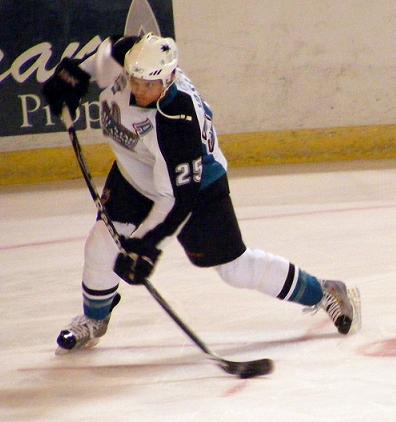
Source: http://world wide web.flickr.com/photos/dinur/2952972685
Thus, the physics taking place here is the transfer of energy from player to stick, and from stick to puck. The advantage of storing free energy in the stick is that (upon release) it strikes the puck faster than the actor can, causing the puck to reach a greater speed.
The Goaltender
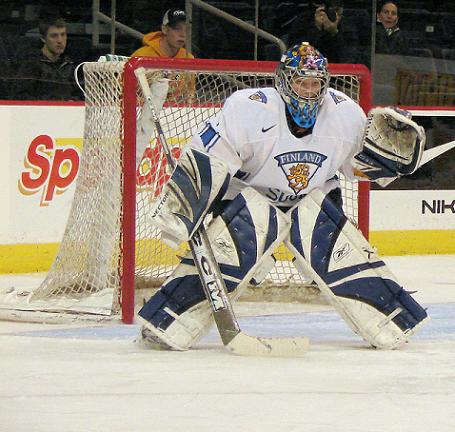
Source: http://www.flickr.com/photos/howlingmad/465762068
The role of the goaltender is to block shots fabricated by the opposing squad. To protect his body from injury he wears protective gear to absorb the touch on of the puck with his body. Due to his loftier level of exposure to high-speed pucks he wears even more protective gear than the other players. All the same, the weight and bulk of the gear can slow down and restrict the movement of the goaltender somewhat. Thus, strength and cardiovascular training, as well as the learning of good technique and efficiency of movement, is an essential part of being a good goaltender.
The Lacrosse Style Goal
This is a particularly interesting discipline in the physics of hockey. In the lacrosse manner goal, the hockey player skillfully maneuvers the puck into the internet, while maintaining contact between puck and blade. The motion-picture show below shows Mike Legg who, in 1996 (while playing for the University of Michigan), scores a lacrosse style goal from behind the net. The approximate trajectory of the puck from water ice to net is represented by the blue curve.
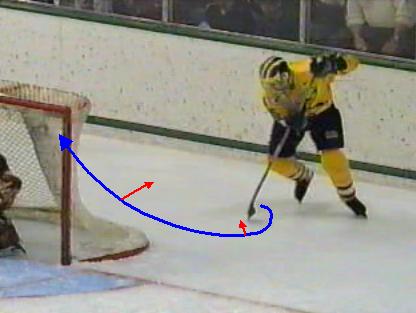
To begin the movement, Mike Legg orients the puck on its edge so that it touches the blade of his stick head on. He then guides the puck along (using the blade of his stick) such that it follows a curved trajectory, as shown. This curved trajectory causes the puck to experience centripetal acceleration. The centripetal dispatch points towards the center of curvature of the bend, in the direction of the red arrows (shown in the moving picture). This centripetal acceleration in plow causes the puck to "button" confronting the bract difficult enough so that information technology doesn't autumn off due to gravity.
At that place are basically 2 things that must happen in lodge for this pull a fast one on to work:
(1) He must move the puck along the trajectory at a high plenty speed (v) to generate a high enough centripetal acceleration (ac ), to generate sufficient contact forcefulness betwixt puck and blade. (Note that ac = vtwo /R, where R is the radius of curvature forth the trajectory).
(2) At the same time, he must orient the bract so that the contact side faces the centre of curvature of the trajectory – in other words, it must face in the direction of the carmine arrows (shown in the picture). This allows the puck to "push" against the bract with enough contact force to avoid falling off due to gravity. This happens past way of the friction strength between bract and puck. The friction strength is proportional to the contact strength. So a loftier enough contact force generates enough friction force to counteract the force of gravity pulling down on the puck.
The lacrosse mode goal must be seen to exist fully understood. To run across this goal made past Mike Legg watch the video below.
Return to The Physics Of Sports page
Return to Real Globe Physics Issues domicile page

Source: https://www.real-world-physics-problems.com/physics-of-hockey.html
Post a Comment for "what is done to a hockey puck to reduce bouncing and friction before a meet"